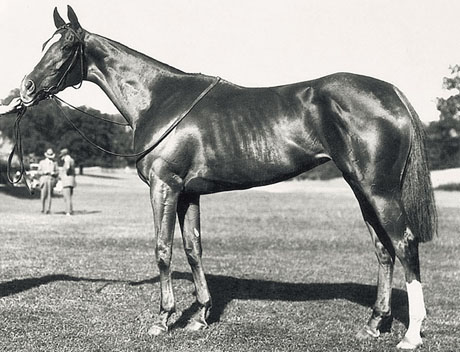Teresina
Family 6d
1920 c. f. Tracery - Blue Tit (Wildfowler)
I thought her a beautiful mare. I buy them really on their looks, if they’re well-bred. She was well-bred and a very beautiful mare. The Honourable George Lambton
The Honourable George Lambton’s understanding of the Thoroughbred was unparalleled among his peers, and it is to that celebrated trainer’s eye to which the Aga Khan III owed much of his success.
On the advice of Katharine Asquith, the Aga Khan wrote to Lambton, her brother-in-law, outlining his ambition to enter the racing world. Lambton’s Newmarket yard was full but he introduced the Aga Khan to Richard Dawson at Whatcombe, thereby setting in motion one of the most fruitful partnerships of the early 20th century.
However, Lambton agreed to do the early buying - and with exceptional results.
“I was to concentrate on fillies,” the trainer recalled in R.C. Lyle’s ‘The Aga Khan’s Horses’, “and only to buy a colt if I felt really keen on him.”
Provided with the required financial ammunition, Lambton came away from the sales at Doncaster in September 1921 having spent 24,250gns on eight yearlings - nearly a seventh of the total yield from the sales that year. Included in the group were Cos, who provided her fledgling owner with a flying start when winning the following year’s Queen Mary Stakes at Royal Ascot.
Yet it was Teresina, the filly who carried the name of the Aga Khan’s wife, the Begum Teresa Aga Khan, who was the most expensive of the pair, with Lambton required to go to 7,700gns in order to stave off the attention of Lord Glanely.
“I myself began to study the breeding of the yearlings that came up for sale at Deauville and Doncaster,” the Aga Khan III wrote in his memoirs. “Among the Doncaster yearlings I chose one in particular that became one of the mares on which I founded my stud, the filly to which I gave the name Teresina.”
“I thought her a beautiful mare,” recalled Lambton. “I buy them really on their looks, if they’re well-bred. She was well-bred and a very beautiful mare.”
Teresina was a later-maturing individual than Cos but come the end of her career, she had amassed nearly £11,000 and a reputation as a fine, courageous stayer.
She wasn’t beaten far when third in the 1923 Oaks and having run second to stablemate Paola in the Coronation Stakes and then to the colt Saltash in the Eclipse Stakes, won the Great Yorkshire Stakes. Placings in the St Leger and Cesarewitch Handicap rounded off that three-year-old season.
Kept in training at four, Teresina had a fruitful second half of the year, notably when winning the Goodwood Cup and Jockey Club Stakes, in which she narrowly denied the previous year’s Derby winner Papyrus in a terrific battle.
Teresina was retired to join the burgeoning broodmare band at Sheshoon Stud in Ireland and didn’t take long to become established as a valuable foundation mare.
The majority of her foals possessed a high level of ability.
Her second foal was Theresina, a daughter of the Aga Khan’s 1924 2000 Guineas winner Diophon, another of Lambton’s yearling purchases, who was trained by Dick Dawson to win the 1930 Irish Oaks and Falmouth Stakes. While Theresina was the best of her foals, a number of the mare’s colts were also high-class including her first foal Grand Terrace, winner of the Champagne Stakes, Gino, who ran third in the 1933 2000 Guineas, and Shahpoor, winner of the Jockey Club Cup. And of the ones who didn’t make it to the track, Alibhai became a successful stallion in the US; sold as a yearling to Louis B. Mayer, Alibhai was retired to stud in California unraced due to injury but went on to sire 54 Stakes winners including Flower Bowl, the dam of Graustark and His Majesty.
Theresina became an important producer in her own right as dam of Ascot Gold Cup winner Ujiji, 1940 St Leger and Irish Derby winner Turkhan and 1950 Coronation Stakes winner Tambara. The Tambara branch of the Theresina line latterly provided the Aga Khan Studs with its Classic-winning miler Sendawar, while that descending from Benane, another Stakes-winning daughter of Theresina, is the source of the Aga Khan’s Noureen family that remains present within the stud today through Group 3 winner Narniyn.
Teresina’s only other daughter, Teretania, has also exerted a major influence on the breed as the ancestress of Juddmonte Farms’ blue hen Toussaud, dam of Empire Maker, Chester House, First Defence and Honest Lady among others. Another celebrated descendant is the Kentucky Derby winner Funny Cide.
Teresina
At 3 years
| Position | Race | Race type | Distance | Racecourse | Year |
|---|---|---|---|---|---|
| 1st | Great Yorkshire Stks | Gr.1 | 12f | York | 1923 |
| 3rd | St Leger Stks | Gr.1 | 15f | Doncaster | 1923 |
At 4 years
| Position | Race | Race type | Distance | Racecourse | Year |
|---|---|---|---|---|---|
| 1st | Jockey Club Cup | Gr.2 | 12f | Newmarket | 1924 |
| 1st | Royal Plate | Gr.2 | 12f | Newbury | 1924 |
| 1st | Goodwood Cup | Gr.2 | 16f | Goodwood | 1924 |
| 2nd | Coronation Stakes | Gr.1 | 8f | Ascot | 1924 |
Racing and Breeding Information supplied by France Galop, the US Jockey Club and Weatherbys Group Limited.

